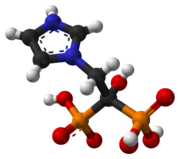Zoledronic acid
 | |
 | |
| Clinical data | |
|---|---|
| AHFS/Drugs.com | Monograph |
| MedlinePlus | a605023 |
| License data |
|
| Pregnancy category |
|
| Routes of administration | Intravenous |
| ATC code | |
| Legal status | |
| Legal status |
|
| Pharmacokinetic data | |
| Protein binding | 22% |
| Metabolism | Nil |
| Elimination half-life | 146 hours |
| Excretion | Renal (partial) |
| Identifiers | |
| |
| CAS Number | |
| PubChem CID | |
| IUPHAR/BPS | |
| DrugBank | |
| ChemSpider | |
| UNII | |
| KEGG | |
| ChEMBL | |
| PDB ligand | |
| CompTox Dashboard (EPA) | |
| Chemical and physical data | |
| Formula | C5H10N2O7P2 |
| Molar mass | 272.09 g/mol g·mol−1 |
| 3D model (JSmol) | |
| |
| |
| | |
Zoledronic acid (INN) or zoledronate is a bisphosphonate drug given intravenously to treat some bone diseases. It is sold under many trade names worldwide.[1]
Mechanism of action
Zoledronic acid slows down bone resorption, allowing the bone-forming cells time to rebuild normal bone and allowing bone remodeling.[2]
Approvals and indications
In all cases administration is by intravenous infusion over a minimum of five minutes.
Bone complications of cancer
Zometa is used to prevent skeletal fractures in patients with cancers such as multiple myeloma and prostate cancer, as well as for treating osteoporosis.[3] It can also be used to treat hypercalcemia of malignancy and can be helpful for treating pain from bone metastases.[4]
It can be administered at home rather than in hospital. Such administration has shown safety and quality-of-life benefits in breast cancer patients with bone metastases.[5]
Osteoporosis
Marketed as Aclasta (in Australia) or Reclast (in the US), zoledronic acid may be given as a 5 mg infusion once per year for treatment of osteoporosis in men and post-menopausal women at increased risk of fracture.
This article needs additional citations for verification. (January 2014) |
In 2007, the U.S. Food and Drug Administration (FDA) also approved Reclast for the treatment of postmenopausal osteoporosis.
This article needs additional citations for verification. (January 2014) |
Paget's disease
As Reclast a single dose of 5 mg is used for the treatment of Paget's disease.
This article needs additional citations for verification. (January 2014) |
Side-effects
Side-effects can include fatigue, anemia, muscle aches, fever, and/or swelling in the feet or legs. Flu-like symptoms are commonly experienced after the first zoledronate infusion, although not subsequent infusions, and are thought to occur because of its potential to activate human γδ T cells (gamma/delta T cells).
There is a risk of severe renal impairment. Appropriate hydration is important prior to administration, as is adequate calcium and vitamin D intake prior to Aclasta therapy in patients with preexisting hypocalcaemia, and for ten days following Aclasta in patients with Paget's disease of the bone. Monitoring for other mineral metabolism disorders and the avoidance of invasive dental procedures for those who develop osteonecrosis of the jaw is recommended.[7]
Zoledronate is rapidly processed via the kidneys; consequently its administration is not recommended for patients with reduced renal function or kidney disease.[8] Some cases of acute renal failure either requiring dialysis or having a fatal outcome following Reclast use have been reported to the U.S. Food and Drug Administration (FDA).[9] This assessment was confirmed by the European Medicines Agency (EMA), whose Committee for Medicinal Products for Human Use (CHMP) specified new contraindications for the medication on 15 December 2011, which include hypocalcaemia and severe renal impairment with a creatinine clearance of less than 35 ml/min.[10]
A rare complication that has been recently observed in cancer patients being treated with bisphosphonates is osteonecrosis of the jaw. This has mainly been seen in patients with multiple myeloma treated with zoledronate who have had dental extractions.[11]
After approving the drug on 8 July 2009, the European Medicines Agency conducted a class review of all bisphosphonates, including Zoledronate, after several cases of atypical fractures were reported.[12] In 2008, the EMA's Pharmacovigilance Working Party (PhVWP) noted that alendronic acid was associated with an increased risk of atypical fracture of the femur that developed with low or no trauma. In April 2010, the PhVWP noted that further data from both the published literature and post-marketing reports were now available which suggested that atypical stress fractures of the femur may be a class effect. The European Medicines Agency then reviewed all case reports of stress fractures in patients treated with bisphosphonates, relevant data from the published literature, and data provided by the companies which market bisphosphonates. The Agency recommended that doctors who prescribe bisphosphonate-containing medicines should be aware that atypical fractures may occur rarely in the femur, especially after long-term use, and that doctors who are prescribing these medicines for the prevention or treatment of osteoporosis should regularly review the need for continued treatment, especially after five or more years of use.[12]
Research
Zoledronic acid has been found to have a direct antitumor effect and to synergistically augment the effects of other antitumor agents in osteosarcoma cells.[13]
Zoledronate has shown significant benefits versus placebo over three years, with a reduced number of vertebral fractures and improved markers of bone density.[14][15] An annual dose of zoledronic acid may also prevent recurring fractures in patients with a previous hip fracture.[16]
Zoledronate also attenuates accumulation of DNA damage in mesenchymal stem cells and protects their function.[17] Given this characteristic, its potential to affect conditions arising from stem-cell dysfunction makes it a promising medicine for a range of age-related diseases[18]
With hormone therapy for breast cancer
An increase in Disease-Free Survival (DFS) was found in the ABCSG-12 trial, in which 1,803 premenopausal women with endocrine-responsive early breast cancer received anastrozole with zoledronic acid.[19] A retrospective analysis of the AZURE trial data revealed a DFS survival advantage, particularly where estrogen had been reduced.[20]
In a meta-analysis of trials where upfront zoledronic acid was given to prevent aromatase inhibitor-associated bone loss, active cancer recurrence appeared to be reduced.[21] The results of clinical studies of adjuvant treatment on early-stage hormone-receptor-positive breast-cancer patients under hormonal treatment – especially with the bisphosphonate zoledronic acid – caused excitement because they demonstrated an additive effect on decreasing disease relapses at bone or other sites. A number of clinical and in vitro and in vivo preclinical studies, which are either ongoing or have just ended, are investigating the mechanism of action and antitumoral activity of bisphosphonates.[22] Ongoing large trials testing bisphosphonates as adjuvant treatment in breast cancer include NSABP B-34,[21] the NATAN trial,[23] and SWOG-S0307.[24] A 2010 review concluded that "adding zoledronic acid 4 mg intravenously every 6 months to endocrine therapy in premenopausal women with hormone receptor-positive early breast cancer ... is cost-effective from a US health care system perspective".[25]
Contraindications
- Poor renal function (e.g. CrCl<30 mL/min)[26]
- Hypocalcaemia
- Pregnancy
- Paralysis
References
- ^ Drugs.com International trade names for zoledronic acid Page accessed Jan 14, 2015
- ^ Aclasta label- Australia
- ^ National Prescribing Service (2009). "Zoledronic Acid for Osteoporosis". Medicines Update, Available at http://www.nps.org.au/consumers/publications/medicine_update/issues/Zoledronic_acid
- ^ http://www.health.gov.il/units/pharmacy/trufot/alonim/533.pdf Zomera prescribing information
- ^ PMID 15870721 Wardley, Davidson Zoledronic acid significantly improves pain scores and quality of life in breast cancer patients with bone metastases: a randomised, crossover study of community vs hospital bisphosphonate administration. Br J Cancer. 2005 May 23; 92(10): 1869–1876. Published online 2005 May 3. doi:10.1038/sj.bjc.6602551. Free Full Text http://www.ncbi.nlm.nih.gov/pmc/articles/PMC2361764/
- ^ www.rheumatology.org http://www.rheumatology.org/Practice/Clinical/Patients/Diseases_And_Conditions/Paget_s_Disease_of_Bone/. Retrieved 2015-07-09.
{{cite web}}: Missing or empty|title=(help) - ^ http://www.nps.org.au/__data/assets/pdf_file/0006/60945/nvcaclin.pdf
- ^ "Zometa 4mg/5ml Concentrate for Solution for Infusion". medicines.org.uk.
- ^ "FDA Alert: Reclast (zoledronic acid): Drug Safety Communication - New Contraindication and Updated Warning on Kidney Impairment". drugs.com.
- ^ "European Medicines Agency - Human medicines". europa.eu.
- ^ Durie BG, Katz M, Crowley J (2005). "Osteonecrosis of the jaw and bisphosphonates". N. Engl. J. Med. 353 (1): 99–102, discussion 99–102. doi:10.1056/NEJM200507073530120. PMID 16000365.
{{cite journal}}: CS1 maint: multiple names: authors list (link) - ^ a b "European Medicines Agency - Human medicines". europa.eu.
- ^ Koto K, Murata H, Kimura S, et al. (July 2010). "Zoledronic acid inhibits proliferation of human fibrosarcoma cells with induction of apoptosis, and shows combined effects with other anticancer agents". Oncol. Rep. 24 (1): 233–9. doi:10.3892/or_00000851. PMID 20514467.
- ^ Reid IR, Brown JP, Burckhardt P, Horowitz Z, Richardson P, Trechsel U, Widmer A, Devogelaer JP, Kaufman JM, Jaeger P, Body JJ, Brandi ML, Broell J, Di Micco R, Genazzani AR, Felsenberg D, Happ J, Hooper MJ, Ittner J, Leb G, Mallmin H, Murray T, Ortolani S, Rubinacci A, Saaf M, Samsioe G, Verbruggen L, Meunier PJ (2002). "Intravenous zoledronic acid in postmenopausal women with low bone mineral density". N. Engl. J. Med. 346 (9): 653–61. doi:10.1056/NEJMoa011807. PMID 11870242.
{{cite journal}}: CS1 maint: multiple names: authors list (link) - ^ Black et al.. Once-Yearly Zoledronic Acid for Treatment of Postmenopausal Osteoporosis. NEJM 2007;356;18;1809-1822. Abstract
- ^ Lyles K, et al. (2007). "Zoledronic Acid and Clinical Fractures and Mortality after Hip Fracture". N. Engl. J. Med. 357 (18): 1799–809. doi:10.1056/NEJMoa074941. PMID 17878149.
- ^ Juhi Misra, Sindhu T. Mohanty, Sanjeev Madan, James A. Fernandes, F. Hal Ebetino, R. Graham, G. Russell, Ilaria Bellantuono. (December 2015). Zoledronate attenuates accumulation of DNA damage in mesenchymal stem cells and protects their function. Stem Cells, doi:10.1002/stem.2255
- ^ "Bone drug protects stem cells from aging." ScienceDaily. 17 December 2015
- ^ PMID 19213681 Gnant, Mlineritsch. Endocrine therapy plus zoledronic acid in premenopausal breast cancer. N Engl J Med 2009; 360:679-691 February 12, 2009 Full Free Text [1]
- ^ Coleman RE, Winter MC, Cameron D, et al. (March 2010). "The effects of adding zoledronic acid to neoadjuvant chemotherapy on tumour response: exploratory evidence for direct anti-tumour activity in breast cancer". Br. J. Cancer. 102 (7): 1099–105. doi:10.1038/sj.bjc.6605604. PMC 2853093. PMID 20234364.
- ^ a b Brufsky A, Bundred N, Coleman R, et al. (May 2008). "Integrated analysis of zoledronic acid for prevention of aromatase inhibitor-associated bone loss in postmenopausal women with early breast cancer receiving adjuvant letrozole". Oncologist. 13 (5): 503–14. doi:10.1634/theoncologist.2007-0206. PMID 18515735.
- ^ Tonyali O, Arslan C, Altundag K (November 2010). "The role of zoledronic acid in the adjuvant treatment of breast cancer: current perspectives". Expert Opin Pharmacother. 11 (16): 2715–25. doi:10.1517/14656566.2010.523699. PMID 20977404.
{{cite journal}}: CS1 maint: multiple names: authors list (link) - ^ http://clinicaltrials.gov/show/NCT00512993 Phase III Postoperative Use of Zoledronic Acid in Breast Cancer Patients After Neoadjuvant Chemotherapy (NATAN)
- ^ "Error". cancer.gov.
- ^ Delea TE, Taneja C, Sofrygin O, Kaura S, Gnant M (August 2010). "Cost-effectiveness of zoledronic acid plus endocrine therapy in premenopausal women with hormone-responsive early breast cancer". Clin. Breast Cancer. 10 (4): 267–74. doi:10.3816/CBC.2010.n.034. PMID 20705558.
{{cite journal}}: CS1 maint: multiple names: authors list (link) - ^ Vondracek, S. F. (2010). "Managing osteoporosis in postmenopausal women". American Journal of Health-System Pharmacy. 67 (7 Suppl 3): S9–19. doi:10.2146/ajhp100076. PMID 20332498.
External links
